|
|
|
|
|
Every hydraulic jack has six main components:
1. A RESERVOIR to hold hydraulic fluid.
2. A PUMP that draws fluid from the resevoir on it's up, suction or intake stroke then creates pressure on it's down/power stroke pushing the fluid through a...
3. CHECK VALVE which after allowing fluid to pass from the resevoir to the pump now 'checks' off the return port to the resevoir and directs the pressurized fluid to the...
4. MAIN CYLINDER where the...
5. RAM PISTON is forced out or upwards as the main cylinder fills with pressurized fluid.
6. After the jack has done it's job and it is time to release the pressure allowing the ram piston to return back into the main cylinder THE RELEASE VALVE is opened and the fluid is ported back into the resevoir so the jacking cycle can be repeated.
The original hydraulic seals were primarily LEATHER and ROPE PACKING. Today, a hundred years later, leather still is being used but has mostly given way to poly-urethane and neoprene. World War II brought about wide spread acceptance of neoprene O-RINGS as an effective yet inexpensive seal and they remain with us today, along with their slightly more effecient cousins, the QUAD RING. O-RING BACK-UP RINGS, first of leather and now commonly of plastic are popularly used to keep the round o-rings from moving around and being distorted in their usually square retaining grooves.
CHEVRON or VEE SEALS, while arguably the best, most durable seals for hydraulic applications over the past 50 years have lost ground to POLYURETHANE U-CUPS and POLY-PACKS which in the last 20 years have proven themselves to be quite excellent seals (plus, require less machine work in the original manufacturing of the jacks).
Rope packing, then later, nylon reinforced neoprene FLAT PACKINGS were widely used from the 30's to the 90's primarily as secondary seals such as piston wipers. Jacks that use flat or rope packing feature an adjustable packing nut or gland nut that allowed users to re-tighten every so often to adjust for wear. Flat packings, while still widely used are losing ground to O-Rings and may become a forgotten 'thing of the past' in the near future as fewer and fewer manufacturers use them in their newer designs.
A jack is mainly comprised of steel, oil, a few pieces of rubber, leather or polyurethane and that's about it. As far as the seals go there's really very little you can do to avoid wear other than use jack stands and keep any blatantly harmful elements from coming in contact with them such as - fire or heat (from welding), alcohol (brake fluid), paint thinners, acids, urine (from pets) and such.
Often we are asked if one should leave the pump piston down or up - and there's no one answer. Many jacks have spring loaded pumps, so, leaving the piston down will have you putting pressure against it for days, weeks and even months at a time. If the jack is not going to be used for quite a while, very likely the next time you go to jack up something you'll find your spring has lost a lot of it's zip. Luckily, in most spring loaded pumps dust covers are used so the exposed piston is not nearly as subject to grit, moisture and such. In a lot of popular Imported floor jacks, however, the pump piston is completely left out in the open while the handle is in the upright position - what do you do? Well, use your head, if you think you may not be using the jack til your next oil change several months away try and wrap a rag around it to keep out contaminants (and remember to take it off before you use the jack). If you use the jack regularly don't worry about it too much, just try and avoid getting water on it (if you hose down your shop) or dust. It would never hurt to wipe the piston down with a paper towel if you haven't used it for some time to make sure it's not loaded up with grit, spider webs and such.
As for the ram piston - keep it retracted.
An often asked question is whether the release valve should be left tightened or loose - I've never heard any official opinions on this from any maker but from our personal experience we'd recommend you keep the release 'finger tight', not really cranked down hard, just slightly set.
Another popular question is - What fluid do I use? About 20 years ago we called several oil companies and asked what they recommended as a general purpose fluid. The closest, Mobil Oil, told us to use DTE Light or DTE 24, so we used that for many years. Ten years ago, tho, they moved several miles away and we went to a nearby Shell Oil distributor and asked for their equivalent - We've been using Shell's Turbo 32 ever since. The truth is - It probably doesn't matter so much what fluid you use as what you should NOT use - and that is Brake Fluid! Yes, BRAKE FLUID is for hydraulic brakes but IT IS NOT HYDRAULIC FLUID! Simply put, it contains alcohol which will pretty much turn most of your seals into JELLO! DO NOT PUT BRAKE FLUID IN YOUR JACK ! Got it?
Still another popular question is - Can I put Transmission fluid in my jack? And our standard answer is - maybe... If you've got a seeping jack that's lost some of it's oil and you need to get a new starter put in or you'll have to walk to work tomorrow - What the hell, put in the trans fluid and use the jack. But as soon as you can swing it get the dang thing fixed, drain out the trans fluid and buy a quart of jack fluid at your local auto supply store, (most stock it or can get it if you ask). Does the trans fluid hurt the jack - we don't know. We have not seen any specific proof one way or another...
NOTE: Most jack manufacturers specify in 'the fine print' that if you use other than their exact fluid you void the warranty. Needless to say, if their jack lost fluid in the period covered by the warranty they haven't made too good of a jack... I personally see it as being ridiculous, like you HAVE TO buy General Motors Power steering fluid or FORD Freon, but their lawyers are nastier than yours, try and play the game if it won't kill you.
For bottle jacks, we're in luck, things are fairly easy - Unless the beast is older than 50 years (they used to put the fillers in the bases way back then) the fillers are usually a little screw or rubber plug about 2/3rds of the way up on the reservoir (aka main rounded outside cylinder of the jack). The filler hole is also the indicator of how much oil to add - Add oil to about 1/8th of an inch below the hole with the jack in the FULLY CLOSED/RETRACTED POSITION.
Standard Bottle Jack Oil Filler Port:
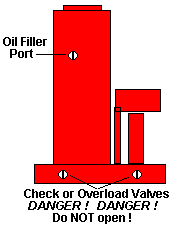
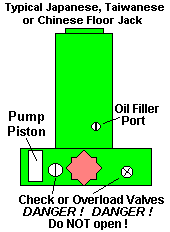
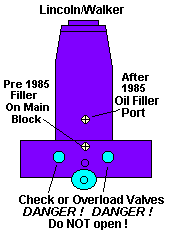
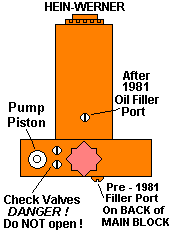
NOTE: The Hein Werner name, retired in the early 90's is now being used by what used to be Lincoln - which makes things quite confusing.
Generally, if it's blue, figure on the Walker/Lincoln configuration, if it's orange figure on the Hein Werner configuration.
ALSO - for a couple of years (2003-2004) Lincoln was sold as a 'Marquette'.
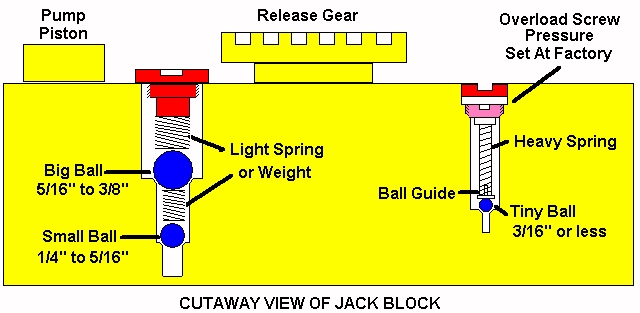
Another popular question we receive is - How do I bleed my jack?
Well, jacks are NOT quite like
the hydraulic brake system of your car. You don't have several feet of
small diameter steel tubing carrying ounces of oil all over the place, so, you
don't really need to bleed them as part of routine care.
If your jack is acting 'spongey' the major reason
generally is that you have a BAD SEAL that is sucking air into the
system or else your kids (or some bugwit neighbor) played around with it
and tried jacking it upside down. Whatever the reason - Here we go:
Jack the jack all the way up/out. Release the release and retract all the way down.
Open the filler plug and you should get a little psssst. Voile'! That's IT!
But MAKE SURE you open the filler plug and NOT a CHECK VALVE - This will
introduce air INTO your system!!!.
Also sometimes, if kids or neighbors have been around, you may lose the prime of your jack. - Set the release valve closed and PULL THE PISTON OUT or UP, open release valve and push back down. This should force oil through the system and catch the prime again - You may have to do it a couple of times.
While we're on fluid... A jack DOES NOT consume fluid. Meaning, after a few years it is normal to have to add fluid - NO! If a jack used to raise to it's maximum height but now does not because it's 'down on fluid' means one of two things - the fluid leaked out the reservoir (Not very likely) or the fluid leaked past the seals (probably). The addition of a little fluid may get your jack back up to snuff for a while but it is generally a temporary solution to a more serious problem - YOU NEED TO PUT IN NEW SEALS or possibly new hardware parts! Sorry.
The lifting capacity of a jack should be an exact thing, shouldn't it? Well it is, sorta, kinda, maybe... Years ago a two ton floor jack used to weigh a lot more, it had a wider base, a bigger ram piston and appeared stronger all the way around. With the flood of import jacks beginning in the 70's things changed. It was our understanding that the imports were NOT tested in any way as to their lifting capacities whereas the American jacks were. If a U.S. made jack said it could lift 2 tons, it damn well could, and usually much more, the 2 ton rating was almost it's minimum rating. At the same time some un-named brand from Taiwan that had a 2 ton rating couldn't lift half of what the American one would - and they got away with it! There simply was NO authority to question the imports claims while the Americans were stuck with government standards all over the place - no wonder the prices were so different for a supposedly equivalent jack! In response, to stay alive the American manufacturers cut, trimmed, shortened, lightened and did about anything they could to compete resulting in a situation where just about all jacks have suffered strength-wise and are the minimal tool for the maximum rating... In otherwords DON'T TRY TO CHEAT THE RATINGS. The American and Japanese jacks WILL lift what they say they will, but NOT a whole lot more. The Chinese and Taiwanese rarely even come close!
Just about half of the jacks that came into our shop for repair were accompanied by the owner's lament - "I lent it to a friend." Don't know what it is exactly but a lent jack is soon a broken jack! People not really familar with jacks seem to think they can lift anything and when no one's looking (and it's not their property to begin with) they try lifting a corner of their 20 ton house with a 2 ton floor jack. God bless 'em, they helped put my daughter through college, but YOU might want to think twice before you lend your jack. Our best advice is a little white lie - tell them you'd be happy to but 'it's not working right', you 'don't want to chance it...' Then tell them that you think the guy down the street with the old Mustang has one. As much as you'd like to - DON'T LEND OUT YOUR JACK!
|
|
|
|
|
Consumer Phone Hours: 9:00 AM til 2:00 PM, Pacific Time, Monday - Friday,
.
OTTO SERVICE CO., PO BOX 1805, Sun Valley, California 91353-1805
United States of America

©2019 OTTO SERVICE